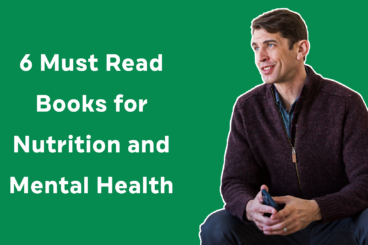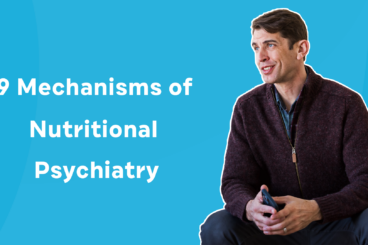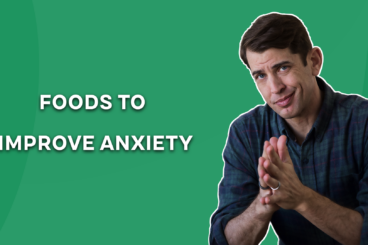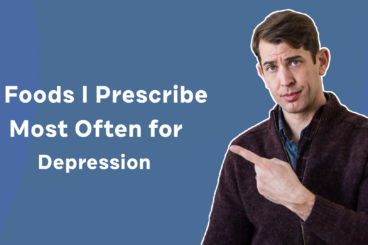People are always asking me what the best foods are for mental health. I put them on the cover of my book but haven’t explained why I chose these to be on the cover. I didn’t put dark chocolate on it just to sell books as a marketing ploy. There are lots of reasons that dark chocolate and the other foods on the cover are great for your mental health. This is all part of nutritional psychiatry, how we can eat to best take care of our mental fitness.
Kale
Let’s start with kale. Kale to me represents nutrient density and leafy greens. It’s a food category that is important in nutritional psychiatry because it has so many nutrients per calorie. There are just 33 calories in a cup of kale and you get more than a hundred percent of your daily needs of vitamin C, vitamin A, vitamin K, and you get folate, fiber, along with phytonutrients.
Red Beans
Red beans are on the cover to help people remember that colorful foods always are packed with phytonutrients and the USDA tells us that small red beans have the most antioxidant capacity of any food we eat, which was surprising to me. One of the reasons that beans are a really important part of a diet is to support our mental health.
Anchovies
Right next to beans on the cover are anchovies. Anchovies, sardines, small fish, and particularly small fish from tins can be a wonderful addition to your diet. It’s a great place to get those long chained omega 3 fats. I talk all about those in this book, and they’re an important part of brain health, brain function, by helping fight inflammation in the brain, which is really important for brain health and mental health. Part of what we’re up against when it comes to beating depression and anxiety is fighting a lot of the inflammation that’s caused by our modern daily lifestyles, but also by what we eat.
Olive Oil
Next to those small fish is olive oil. Olive oil should be the main fat in your house if you’re eating lots of plants and oven roasting lots of cruciferous vegetables. Olive oil is a great fat to help you pull out some of those nutrients that are fat soluble such as vitamin K, D, and E but also some of the phytonutrients like lycopene that are fat soluble. Olive oil is also really interesting since it’s made up of an omega nine fat, has some vitamin E, a lot of anti-inflammatory properties, and it just so happens that most of the studies that look at things like food and depression look at the Mediterranean diet, which is said to have positive effects in terms of the prevention and treatment of depression.
Avocado
Next up is avocado. People need to really understand that our brain is made of fat. When your brain is made of fat, you need to protect fat and you need to eat the right types of fats. Avocados are also a great source of vitamin E and monounsaturated oleic acid, the same fat that’s in the olive oil. Avocados also just make a great snack and they’re a wonderful food to add into your diet.
Dark Chocolate
Next to the avocado is dark chocolate. Dark chocolate is a plant-based food. The darker it is the better. It’s fermented, full of fiber, magnesium, and iron. It’s really a brain food. There are some studies about concentrations made from the flavanols and flavanoids in cacao, which is what we make chocolate out of, that have been shown to reverse age related, memory declines. So it is a potentially very powerful food. Also, so many people I meet who are struggling with depression and anxiety struggle with carbohydrate craving or with wanting sweets so dark chocolate gives us a brain healthy, delicious way to enjoy those.
Egg
The egg is a controversial food, but is a wonderful source of a perfect protein, just 70 calories in an egg. Eggs also are a great source of choline. Choline is a nutrient we don’t find in many foods but we use it to make phosphatidylcholine a really important neurotransmitter and brain molecule when it comes to learning. Also eggs are a nice addition to a lot of plants.
Pumpkin Seeds
I love pumpkin seeds because I’m always looking to add zinc, magnesium and fiber into all of my dishes. Those are all great brain nutrients. Zinc is one of those nutrients linked directly to brain derived neurotrophic factor. One of the nutrients that really helps our brain grow and be resilient. Pumpkin seeds are a really low cost, wonderful food. I put them in pesto, salads, cook my fish with them. There are all kinds of ways to use pumpkin seeds.
Red Peppers
Finally, there are red peppers. Red peppers are an example of a rainbow food that we all should be adding to our plates. Red peppers are high vitamin C. There are lots of ways to enjoy peppers such as roasting them or eating them raw with hummus.
I hope that makes sense why these foods are on the cover of Eat to Beat Depression and Anxiety. They are there to really help illustrate some of the fundamental principles in the book, but also to give us something to reference when it’s time to go to the grocery store. This way you’ve got some really clear options and some reasons for feeding your mental health.




Wonderful comments that help me understand why all these foods I love and enjoy regularly, are so good for my mental health! Thank you!